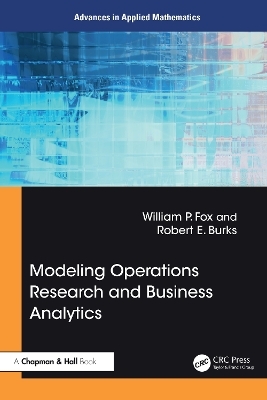
Modeling Operations Research and Business Analytics
Chapman & Hall/CRC (Verlag)
978-1-032-73592-4 (ISBN)
This book provides sample exercises, techniques, and solutions to employ mathematical modeling to solve problems in Operations Research and Business Analytics. Each chapter begins with a scenario and includes exercises built on realistic problems faced by managers and others working in operations research, business analytics, and other fields employing applied mathematics. A set of assumptions is presented, and then a model is formulated. A solution is offered, followed by examples of how that model can be used to address related issues.
Key elements of this book include the most common problems the authors have encountered over research and while consulting the fields including inventory theory, facilities' location, linear and integer programming, assignment, transportation and shipping, critical path, dynamic programming, queuing models, simulation models, reliability of system, multi-attribute decision-making, and game theory.
In the hands of an experienced professional, mathematical modeling can be a powerful tool. This book presents situations and models to help both professionals and students learn to employ these techniques to improve outcomes and to make addressing real business problems easier. The book is essential for all managers and others who would use mathematics to improve their problem-solving techniques.
No previous exposure to mathematical modeling is required. The book can then be used for a first course on modeling, or by those with more experience who want to refresh their memories when they find themselves facing real-world problems. The problems chosen are presented to represent those faced by practitioners.
The authors have been teaching mathematical modeling to students and professionals for nearly 40 years. This book is presented to offer their experience and techniques to instructors, students, and professionals.
Dr. William P. Fox is currently a visiting professor of Computational Operations Research at the College of William and Mary. He is an emeritus professor in the Department of Defense Analysis at the Naval Postgraduate School and teaches a three-course sequence in mathematical modeling for decision making. He received his Ph.D. in Industrial Engineering from Clemson University. He has taught at the United States Military Academy for twelve years until retiring and at Francis Marion University where he was the chair of mathematics for eight years. He has many publications and scholarly activities including twenty plus books and one hundred and fifty journal articles. Colonel (R) Robert E. Burks, Jr., Ph.D. is an Associate Professor in the Defense Analysis Department of the Naval Postgraduate School (NPS) and the Director of the NPS’ Wargaming Center. He holds a Ph.D. in Operations Research from the Air Force Institute of Technology. He is a retired logistics Army Colonel with more than thirty years of military experience in leadership, advanced analytics, decision modeling, and logistics operations who served as an Army Operations Research analyst at the Naval Postgraduate School, TRADOC Analysis Center, United States Military Academy, and the United States Army Recruiting Command. Other books by William P. Fox and Robert E. Burks: Advanced Mathematical Modeling with Technology, 2021, CRC Press. Other books by William P. Fox from CRC Press: Probability and Statistics for Engineering and the Sciences with Modeling using R (w/Rodney X. Sturdivant, 2023, CRC Press Mathematical Modeling in the Age of the Pandemic, 2021, CRC Press. Advanced Problem Solving Using Maple: Applied Mathematics, Operations Research, Business Analytics, and Decision Analysis (w/William Bauldry), 2020, CRC Press. Mathematical Modeling with Excel (w/Brian Albright), 2020, CRC Press. Nonlinear Optimization: Models and Applications, 2020, CRC Press. Advanced Problem Solving with Maple: A First Course (w/William Bauldry), 2019. CRC Press. Mathematical Modeling for Business Analytics, 2018, CRC Press.
1. Chapter 1. Inventory Problem
1.1 Introduction
1.2 Inventory Problems
1.3 Inventory and Economic Order Quantity (EOQ)
1.3.1 Inventory Analysis with EOQ formula driven approach
1.3.2 Time Invariant Asphalt EOQ model
1.4 Facility Location with an Oil Rig Location Problem
1.5 Computer Cabling Location of Central Computer
1.6 Exercises
1.7 References
2. Chapter 2 Product Mix: Linear Programming Problems
2.1 Linear Programing Problem Introduction
2.2 Simple Manufacturing Example
2.3 Financial Planning
2.4 Blending Formulation Example
2.5 Production Planning Problem
2.6 Shipping Problem
2.7 Product Mix
2.8 Supply Chain Operations (Gasoline Distribution)
2.9 Product Mix with LINDO
2.10 Exercises
2.11 References and Additional Readings
3. Chapter 3 Transportation and Shipping Problems
3.1 Transportation and Shipping Revisited
3.2 Transportation and Shipping Warehouse Problem
3.2.1 Modification to the Warehouse Problem
3.3 Transportation Network
3.4 Exercises
3.5 References and Additional Readings
4. Chapter 4 Assignment Models
4.1 Training Centers and Offices
4.1.1 Assignment Problem
4.2 Exercises
4.3 References and Additional Readings
5. Chapter 5 Mathematical Programming Methods
5.1 Data Envelopment Analysis (DEA)
5.2 Manufacturing Problem with DEA
5.3 Shortest Path Problems
5.3.1 Network analysis
5.3.2 . Kruskal’s Method for Network Analysis Problem
5.3.3 Prim’s Algorithm
5.3.4 Dijkstra’s Algorithm
5.4 Maximum Flow Problem
5.4.1 Example 5.1. Max Flow through a given network
5.5 Critical Path in Project Plan Network
5.5.1 Example 5.2. CPM
5.6 Minimum Cost Flow Problem
5.6.1 Example 5.3. Min cost flow through a network
5.7 General Integer Linear Programs
5.7.1 Example 5.4. Manufacturing Equipment
5.7.2 Example 5.5. Integer LP Programs by EXCEL
5.8 Mixed Integer Programming Application: "Either-Or" Constraints
5.8.1 Conditional Relations Among Constraints
5.8.2 A Case of Discrete Finite Valued Variable
5.8.3 0 - 1 Integer Linear Programs
5.9 Illustrious Example
5.9.1 Example 5.7. Consider the following Knapsack Problem
5.9.2 Example 5.8. Traveling Salesperson Problem
5.9.3 Example 5.9. Capital Budgeting Applications
5.9.4 Example 5.10. Marketing Application
5.9.5 Example 5.11. The Cutting Stock Problem
5.10 An Engineering Application: Mixing Substances
5.11 Exercises
5.12 References and Additional Readings
6. Chapter 6 Resource Allocation Models using Dynamic Programming
6.1 Introduction: Basic Concepts and Theory
6.2 Characteristics of Dynamic Programming
6.2.1 Working Backwards
6.2.2 Example 6.1 A Knapsack Problem.
6.3 Modeling and Applications of Discrete Dynamic Programming
6.3.1 Oil Well Investment DP Application
6.4 Exercises
6.5 References and Suggested Readings
7. Chapter 7 Queuing Models
7.1 Introduction to Queuing Theory
7.1.1 Simple Fast Food Service Queue Example 7.1
7.2 The Multi-server Problems
7.3 Exercises
7.4 References and Suggested Readings
8. Chapter 8 Simulation Models
8.1 Missile Attack
8.2 Gasoline-Inventory simulation
8.3 Queuing model
8.4 R Applied simulation
8.5 Exercises
8.6 References and Additional Readings
9. Chapter 9 System Reliability Modeling
9.1 Introduction to Reliability Modeling
9.2 Modeling Component Reliability
9.2.1 Battery Problem – Reliability Example 9.1
9.2.2 Battery Problem Revisited – Reliability Example 9.2
9.3 Modeling series and parallel components
9.3.1 Modeling Series Systems
9.3.2 Radio Components – Example 9.3
9.3.3 Modeling Parallel Systems (Two Components)
9.3.4 Parallel Bridges – Example 9.4
9.4 Modeling Active Redundant Systems
9.4.1 Manufacturing – Example 9.5
9.5 Modeling Standby Redundant Systems
9.5.1 Battery Problems Revisited for Stand-by – Example 9.6
9.5.2 Stake Out Problem Revisited – Example 9.7
9.6 Models of Large Scale Systems
9.7 Exercises
9.8 References and Suggested Readings
10. Chapter 10 Modeling Decision Making with Multi-Attribute Decision Modeling with Technology
10.1 Introduction
10.2 Delphi Method
10.2.1 Pairwise Comparison by Saaty (AHP)
10.2.2 Entropy Method
10.3 Simple Additive Weights (SAW) Method
10.4 Technique of Order Preference by Similarly to the Ideal Solution (TOPSIS)
10.5 Modeling of Ranking Units using Data Envelopment Analysis (DEA) with Linear Programming
10.6 Technology for Multi-Attribute Decision Making (MADM)
10.6.1 Technology and Simple Additive Weights
10.7 Exercises
10.8 References and Suggested Readings.
11. Chapter 11 Regression Techniques
11.1 Introduction to Regression Techniques
11.1.1 Correlation, covariance, and its misconceptions
11.1.2 Correlation: A Measure of LINEAR relationship
11.1.3 Calculating the Correlation
11.1.4 Correlation for Global Warming Data Example 11.1
11.1.5 Testing the Significance of a Correlation with hypothesis testing
11.2 Model Fitting and Least Squares
11.2.1 Global Warming Example 11.1
11.3 The Different Curve Fitting Criterion
11.3.1 A Least-Squares Fit Explosive Data Example 11.2
11.4 Diagnostics and Interpretations
11.4.1 Fruit Flies Over Time – Example 11.4
11.4.2 Revisit Explosive Problem – Example 11.5
11.4.3 Revisit the Cubic Model – Example 11.6
11.5 Diagnostics and Inferential Statistics
11.5.1 The Spring Mass System Using R
11.5.2 Simple Linear Regression Model with complete explanation summary in R
11.6 Polynomial Regression in R
11.6.1 Recovery Level Versus Time – Example 11.8
11.6.2 Wheat Production Revisited
11.7 Exercises
11.8 References and Suggested Readings
12. Chapter 12 Marketing Strategies and Competition Using Game Theory.
12.1 Total Conflict Games
12.1.1 Market Shares
12.1.2 Hitter-Pitcher Dual – A Conflict Game Example
12.1.3 The Expanded Hitter-Pitcher Dual
12.2 The Partial Conflict Game Analysis without Communication
12.3 Methods to Obtain the Equalizing Strategies
12.3.1 Linear Programming with Two Players and Two Strategies Each
12.4 Nash Arbitration Method
12.4.1 R and the Nash Arbitration Method
12.5 Exercises
12.6 References and Additional Readings
13. Index
| Erscheinungsdatum | 03.09.2024 |
|---|---|
| Reihe/Serie | Advances in Applied Mathematics |
| Zusatzinfo | 77 Tables, black and white; 83 Line drawings, black and white; 83 Illustrations, black and white |
| Sprache | englisch |
| Maße | 156 x 234 mm |
| Gewicht | 510 g |
| Themenwelt | Mathematik / Informatik ► Mathematik ► Angewandte Mathematik |
| Technik ► Umwelttechnik / Biotechnologie | |
| Wirtschaft ► Betriebswirtschaft / Management ► Logistik / Produktion | |
| ISBN-10 | 1-032-73592-9 / 1032735929 |
| ISBN-13 | 978-1-032-73592-4 / 9781032735924 |
| Zustand | Neuware |
| Informationen gemäß Produktsicherheitsverordnung (GPSR) | |
| Haben Sie eine Frage zum Produkt? |
aus dem Bereich


